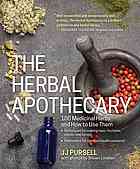The Herbal Apothecary 100 medicinal herbs and how to use them./ JJ Pursell, 2015. Photos by Shawn Linehan. Timber Press, Oregon. 292 p. Illustrations in color.

For anyone who is excited by the possibility of applying herbs to their health, The Herbal Apothecary 100 Medicinal Herbs and How to Use Them by JJ Pursell is an educational kit worth exploiting. In less than 300 pages, contained in the shape of a handbook rather than a heavy tome, is an encyclopedia of knowledge you need on herbal treatments. Covered by herbs are conditions ranging from women’s complaints to the common cold; author Pursell’s easy to read descriptions and explanations allow for access to better health with natural substances.
The herbs are listed alphabetically by common name from agrimony to yellow dock. Descriptions include botanical names, listed medicinal aspects and constituents, and sections on “Medicinal uses” and “Identification and cultivation”. Many of the herbs are native to the continental U.S. and Canada, or naturalized here after having been imported by European settlers early on.
However, recent introductions or newly recognized or popular in the U.S. have also been included. Each entry is set with two photographs for identification: one a close-up that shows the character of the herb and blooms (where applicable) and another image of the herb in its location, surrounded by other plants for size and aspect.
Note that this collection of herbs is distinctive: typically each herbal has a unique locus due to the choice of plants they describe. The Herbal Apothecary is no exception. While offering 100 herbs as a collection, the text also reveals usage for dozens more—a position which I understand as widening opportunities for learning about medicinal herbs.
For example, the collection doesn’t include garlic, ginger, eleuthero, etc., but the text makes mention of these herbs as does the author’s bibliography. So even if you cannot compare ginger and garlic or eleuthero with other herbs in the collection, you still read about how they’re the herb of choice in particular situations. All in all, this collection of herbs will expand your repertoire if you are already practicing herbal medicine.
Beyond the 100 herbs identified and described, special sections orient the reader to working with herbs. You can utilize Pursell’s instructions to make herbal preparations like tea blends or tincture mixes in cases of acne, chest cold, insomnia. Pursell teaches you how to construct a simple herbal formula that will guide the herbs chosen for a specific effect to the appropriate part of the body. You can make herbal oils and salves, syrups and vinegars to begin with and later progress to more exacting methods.
In Herbal Treatment Plans, Pursell notes dosage and recipes for each ailment. There are also tables and charts—handy references. One sets forth equivalents in metric conversions, specifically US volume measure to milliliters and US weight measure to grams.
One of the best aspects of the book is the ease with which herbs are described for specific conditions and problems encountered in healing. Even though you are reading concise material, the tone of the text is casual and at the same time specific. Each entry contains the section “Contraindications”, assuring the reader of an herb’s relative safety, or dangerous qualities, if they exist.
Under “Medicinal Uses” in each monograph, the author sites major energy of the herb to bring about health. Just some of these aspects are characterized as “reduces irritation”, “supports lung and improves sinustitis”, “activates cells that attack cancer”, “relieves inflammatory pain”, “stimulates uterus”, “reduces fever”, “strengthen tissues and nerves”, “calms and relaxes the system”, and others according to the herb and its healing qualities.
You can view Dr. JJ Pursell’s website at The Herb Shoppe
Follow


